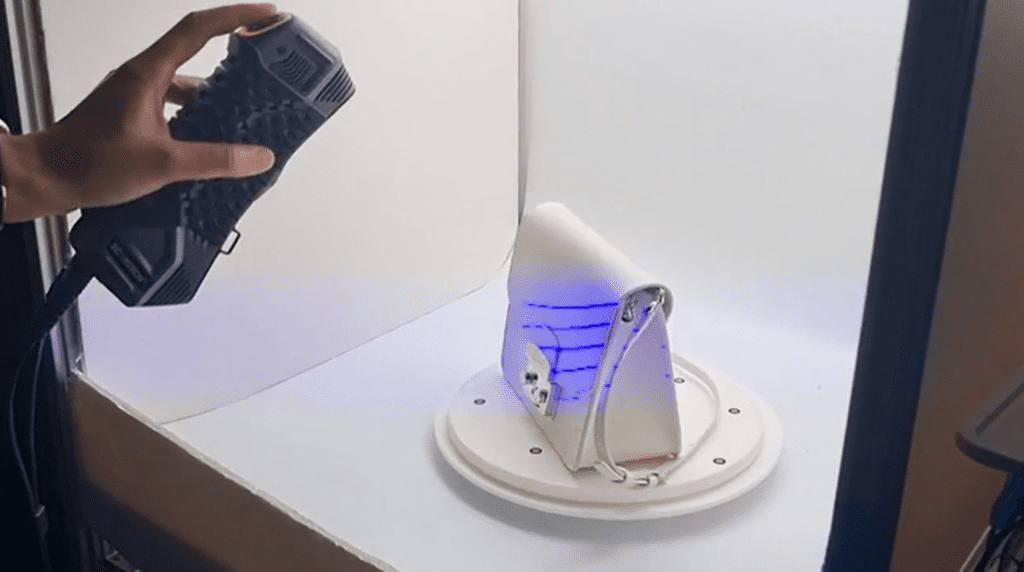When you stumble upon 3D renderings of a product, you might wonder: how is it done? Where does it start? Some 3D visuals start with 3D scans. However, it is not the case for every 3D render.
If the idea of 3D scans is blurry for you, then you are on the right page. In this article, we provide you with 3 ways to embrace 3D scans for you to understand the powerful aspect that 3D scans can bring to your brand.
The first and most obvious use your brand could make of our 3D scanning services is a 3D visualization of the product. The high-quality mesh we provide you after the 3D scan will enable you to create photorealistic 3D renderings. As a result, your conversion rates are very likely to increase. To illustrate, 44% [1] of shoppers are more likely to buy a product after trying it out in 3D.
With SmartPixels’ 3D renderings, your customers will be able to visualize a 3D version of their product in a more dynamic and interactive way. They could view their product from any angle, from a 360° view, zooming in and out, increasing their satisfaction.
With SmartPixels, we make sure that the 3D product visual perfectly matches the physical product. You could say that the 3D product visual is a digital twin. Therefore, your brand can benefit from reduced product returns.
Indeed, the main reason for returned articles in the fashion industry is the discrepancies between the visual shown on the e-commerce website and the actual product received. In fact, in the luxury industry, 25% [2] of purchases made online are returned to their issuing brands.
SmartPixels have been involved in numerous projects to create digital twins such as Paco Rabanne for its Olympéa perfume. SmartPixels helps you enhance your product visualization online while reducing your product returns. Our clients testified!
Another way to embrace our 3D scanning services is by introducing customizable products to your product offers. Not only do you gain an additional differentiating factor to your brand’s uniqueness, but you also guarantee multiple benefits.
First, according to a study by Shopify, 50% [3] of consumers have stated that they would be more likely to purchase from a brand if they offered a personalized experience. Therefore, you ensure your brand repeat customers and positive word-of-mouth, increasing your sales.
Then, you can increase your margins as shoppers would be ready to pay a 40% of shoppers would pay a premium [4] to live a customization experience in AR (using 3D). Consequently, you could increase your revenues with production costs remaining constant.
Finally, you can reduce your carbon footprint with made-to-order production methods. Due to the unpredictability of the product demands, customized articles can only be produced once ordered, reducing the 92 billion tons [5] of waste generated each year, and the 2 billion dollars [6] of greenhouse gas emissions.
Finally, using 3D scanning can be useful to Augmented Reality and NFT creation.
On the one hand, Augmented Reality can be leveraged for your marketing strategies to attract new clients and stir up your customers’ curiosity about your brand. Indeed, Augmented Reality has a promising market that has been growing strong these past few years. It is predicted to reach a worth of 88.6 billion $USD [7].
The use of AR has been extended from video games to the luxury industry as a way to keep current clientele coming, attract new customers and expose the innovative sides of fashion luxury brands. Therefore, through 3D scans, leveraging the potential of AR is at the tip of your reach.
On the other hand, another way to leverage 3D scans is through NFT or avatar creation. An increasing number of brands are starting to implement themselves through NFT sales. Several of them use this feature as a reward for customer loyalty.
For example, Dior is going to launch the B33 shoe NFTs in the fall. The brand offers the opportunity to obtain a B33 digital twin as an NFT that also gives its holder exclusive early access to the Spring/Summer collection of 2024.
Other brands opted for the sale of articles that can only be sold in certain brands’ virtual worlds or to avatars. That is the case for Valentino and its virtual outfits.
Overall, brands prefer turning to 3D scans for practical reasons if the project circumstances allow it.
Indeed, 3D scans are the key to an endless list of possibilities regarding its use once it has been turned into photorealistic 3D renderings. From digital twins to new product customization offers on your e-commerce website, to an expansion onto very promising markets, the power of 3D scans is unquantifiable.
SmartPixels is committed to providing your brand with high-quality 3D scans of your products. Reach out to the team so they can understand your needs and grant you product-tailored 3D scans.
Sources:
[1] https://apnews.com/press-release/globe-newswire/technology-business-lifestyle-79fe640885f900736beed0fe33f7d972
[2] https://zigzag.global/the-luxury-retail-sector-trends-in-ecommerce-and-returns/
[3] https://www.shopify.com/enterprise/personalization-trends#:~:text=In%20a%20recent%20study%2C%2049,experience%20by%20a%20retail%20brand
[4] https://www.syniverse.com/blog/mobile-marketing/augmented-reality-hospitality-industry/#:~:text=The%20survey%20shows%20that%2061,already%20using%20AR%20while%20shopping
[5] https://goodonyou.eco/waste-luxury-fashion/
[6] https://hashtagpaid.com/banknotes/how-and-why-luxury-fashion-brands-are-focusing-on-sustainable-alternatives#:~:text=Luxury%20fashion%20has%20a%20problem,%2C%20Germany%2C%20and%20the%20UK.
[7] https://www.marketsandmarkets.com/Market-Reports/augmented-reality-market-82758548.html
